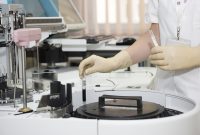-
Table of Contents
- Introduction
- Exploring the Impact of Artificial Intelligence on the Future of Food
- How Robotics and Automation are Changing the Way We Eat
- The Potential of 3D Printing in the Food Industry
- The Benefits of Lab-Grown Meat and Its Impact on the Food System
- Examining the Role of Big Data in the Future of Food Production
- Conclusion
“Discover the Innovative Ways Technology is Transforming the Way We Eat!”
Introduction
The Future of Food: How Technology is Shaping Our Meals is an exploration of the ways in which technology is transforming the way we eat. From the rise of lab-grown meat to the development of new food delivery services, this article examines the impact of technology on the food industry and how it is changing the way we consume food. It looks at the potential benefits and drawbacks of these new technologies, as well as the ethical implications of their use. Finally, it considers the potential implications of these changes for the future of food and our diets.
Exploring the Impact of Artificial Intelligence on the Future of Food

The future of food is an exciting topic, and one that is increasingly being shaped by the emergence of artificial intelligence (AI). AI is already being used in a variety of ways to improve the food industry, from helping farmers increase crop yields to helping restaurants create more efficient menus. But what will the impact of AI be on the future of food?
One of the most significant impacts of AI on the food industry is the potential for automation. AI-driven robots and machines can be used to automate many of the labor-intensive tasks associated with food production, such as harvesting, packaging, and delivery. This could lead to a more efficient and cost-effective food production process, as well as a reduction in labor costs.
AI can also be used to improve the quality of food. AI-driven algorithms can be used to analyze data from various sources, such as soil and weather conditions, to determine the best time to plant and harvest crops. This could lead to higher yields and better quality produce. AI can also be used to monitor food safety, ensuring that food is safe to eat and free from contamination.
AI can also be used to improve the customer experience. AI-driven chatbots can be used to provide customers with personalized recommendations and advice. AI can also be used to analyze customer feedback and preferences, allowing restaurants to create more tailored menus and experiences.
Finally, AI can be used to reduce food waste. AI-driven algorithms can be used to analyze data from various sources, such as grocery stores and restaurants, to determine which foods are most likely to go to waste. This could lead to a reduction in food waste, as well as a more efficient use of resources.
The impact of AI on the future of food is likely to be significant. AI-driven automation, improved quality, better customer experiences, and reduced food waste are just some of the potential benefits that AI could bring to the food industry. As AI continues to evolve, it is likely that its impact on the future of food will only become more pronounced.
How Robotics and Automation are Changing the Way We Eat
Robotics and automation are revolutionizing the way we eat. From the way food is grown and harvested to the way it is prepared and served, robots and automation are transforming the food industry.
Robots are being used to grow and harvest crops. Automated systems are being used to monitor soil conditions, water levels, and other environmental factors to ensure optimal crop growth. Automated harvesting machines are being used to pick fruits and vegetables with greater speed and accuracy than ever before.
Robots are also being used to prepare food. Automated systems are being used to mix ingredients, measure portions, and cook food with greater precision than ever before. Automated systems are also being used to package food for delivery, ensuring that food arrives fresh and ready to eat.
Robots are also being used to serve food. Automated systems are being used to deliver food to customers, ensuring that orders are accurate and delivered quickly. Automated systems are also being used to clean and sanitize dishes, ensuring that customers are served food in a safe and hygienic environment.
Robotics and automation are also being used to improve the customer experience. Automated systems are being used to take orders, process payments, and provide customers with personalized recommendations. Automated systems are also being used to provide customers with nutritional information, helping them make healthier food choices.
Robotics and automation are transforming the way we eat. From the way food is grown and harvested to the way it is prepared and served, robots and automation are making it easier and more efficient to enjoy delicious meals.
The Potential of 3D Printing in the Food Industry
The food industry is undergoing a revolution, and 3D printing is at the forefront of this transformation. 3D printing technology has the potential to revolutionize the way food is produced, distributed, and consumed.
3D printing has already been used to create a variety of food products, including chocolates, cookies, and even pizzas. This technology has the potential to revolutionize the way food is produced, as it allows for the creation of complex shapes and intricate designs that would be impossible to achieve with traditional manufacturing methods. Additionally, 3D printing can be used to create customized food products, allowing for greater personalization and customization.
3D printing can also be used to reduce food waste. By printing food products on demand, food producers can reduce the amount of food that is wasted due to overproduction or spoilage. This could have a significant impact on the environment, as food waste is a major contributor to global warming.
Finally, 3D printing can be used to improve the safety and quality of food products. By printing food products with precise measurements and ingredients, food producers can ensure that their products are safe and of the highest quality. This could lead to a reduction in food-borne illnesses and an overall improvement in the safety and quality of food products.
The potential of 3D printing in the food industry is immense. This technology has the potential to revolutionize the way food is produced, distributed, and consumed. As 3D printing technology continues to evolve, it is likely that we will see more and more applications of this technology in the food industry.
The Benefits of Lab-Grown Meat and Its Impact on the Food System
The food system is undergoing a revolution, and lab-grown meat is at the forefront of this change. Lab-grown meat, also known as cultured meat, is a type of meat that is produced in a laboratory setting using animal cells. It is a sustainable and ethical alternative to traditional animal-based meat, and it has the potential to revolutionize the food system.
Lab-grown meat has numerous benefits over traditional animal-based meat. For starters, it is more sustainable. Lab-grown meat does not require the use of land, water, or other resources that are necessary for raising livestock. This means that it has a much lower environmental impact than traditional animal-based meat. Additionally, lab-grown meat does not require the use of antibiotics or hormones, which are often used in animal-based meat production. This makes it a healthier option for consumers.
Lab-grown meat also has the potential to reduce animal suffering. Since lab-grown meat does not require the use of animals, it eliminates the need for factory farming and other cruel practices that are often used in animal-based meat production. This makes it a more ethical option for those who are concerned about animal welfare.
Finally, lab-grown meat has the potential to reduce food insecurity. Since it does not require the use of land, water, or other resources, it can be produced in areas where traditional animal-based meat production is not feasible. This could help to reduce hunger and malnutrition in areas where food insecurity is a major issue.
Overall, lab-grown meat has the potential to revolutionize the food system. It is a sustainable and ethical alternative to traditional animal-based meat, and it has numerous benefits for both consumers and the environment. As the technology continues to improve, lab-grown meat could become a viable option for those looking for a healthier and more sustainable way to get their protein.
Examining the Role of Big Data in the Future of Food Production
The future of food production is increasingly being shaped by the power of big data. As the world’s population continues to grow, the demand for food is also increasing. To meet this demand, food producers must be able to efficiently and effectively manage their resources. Big data is playing an increasingly important role in helping food producers to do just that.
Big data is being used to help food producers better understand their customers and their needs. By collecting and analyzing data from customer surveys, social media, and other sources, food producers can gain valuable insights into what their customers want and how they can best meet those needs. This data can then be used to develop new products, optimize production processes, and improve customer service.
Big data is also being used to help food producers better manage their resources. By collecting and analyzing data from sensors, drones, and other sources, food producers can gain a better understanding of their production processes and the resources they need to produce food efficiently and effectively. This data can then be used to optimize production processes, reduce waste, and improve the quality of the food they produce.
Finally, big data is being used to help food producers better understand the environmental impact of their operations. By collecting and analyzing data from sensors, drones, and other sources, food producers can gain a better understanding of the environmental impact of their operations. This data can then be used to reduce their environmental footprint and ensure that their operations are sustainable.
Big data is playing an increasingly important role in the future of food production. By collecting and analyzing data from customers, resources, and the environment, food producers can gain valuable insights that can help them to produce food more efficiently and effectively. As the demand for food continues to grow, big data will become even more important in helping food producers meet this demand.
Conclusion
The Future of Food is an exciting and rapidly evolving field. With the help of technology, we are able to create more sustainable, nutritious, and delicious meals. We are also able to reduce food waste and increase access to healthy food. Technology is helping us to create a more sustainable and equitable food system that will benefit everyone. As technology continues to advance, we can expect to see even more innovative and exciting developments in the future of food.















